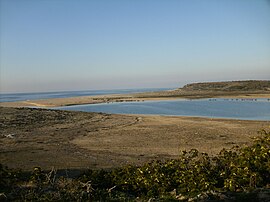Melides
Melides | |
|---|---|
 Lagoon and beach | |
| Coordinates: 38°10′N 8°44′W / 38.167°N 8.733°W | |
| Country | |
| Region | Alentejo |
| District | Setúbal |
| Area | |
| • Total | 155.2 km2 (59.9 sq mi) |
| Population (2021) | |
| • Total | 1,459 |
| • Density | 9.4/km2 (24/sq mi) |
| Time zone | UTC±00:00 (WET) |
| • Summer (DST) | UTC+01:00 (WEST) |
Melides (pronounced [mɨˈliðɨʃ], locally [mɫidʒ̊]) is a parish in the Grândola municipality in the Setúbal District of Portugal. It has an area of 155.2 km2 and had 1,459 inhabitants as of the census of 2021. The agricultural parish borders the Atlantic Ocean and has become a popular area for summer homes.[1] The village is located directly east of the Melides lagoon and its floodplain and its surrounding landscape includes forests of eucalyptus, pine and cork.[2]
History
[edit]Human occupation of the area dates back to the Neolithic era. The Dolmen of Pedra Branca is a megalithic burial tomb from around 2500 BCE, while the Necrópole de Cistas das Casas Velhas is a Bronze Age necropolis. Both can be visited.[3][2]
The village is believed to date back to the end of the 15th century, when a parish was created in the church of St. Marinha. It is believed to have been formed by the gradual concentration of houses from fishermen and farmers who lived in the vicinity.[2]
The village possessed a small fishing port, but during the second half of the 16th century, silting closed off the lagoon's exit to the sea. Subsequently, the village's activity turned progressively towards agriculture and the production of pottery and cork products.[2]
On 23 January 1626, a Dutch ship named Schoonhoven owned by the Dutch East India Company sank off the coast of Melides. Ship remains that may have belonged to Schoonhoven have been found inside the Melides lagoon by divers and in February 2021 in the sand bank, following heavy rainfall.[4]
In the 18th century, St. Peter's church in Melides was built in the location of an existing shrine to St. Peter. This replaced the church of Santa Marinha, which was located outside of the old village's center.[2]
In 1870, Melides became part of the municipality of Santiago do Cacém. In 1895, it returned to being part of the Grândola municipality.[2]
Present day
[edit]During the summer, the beaches in Melides attract tourists, contributing to the village's economy. There are a large number of summer houses near the beach, in the village and the surrounding hills.[2] In the parish, there is a luxury resort, with a golf course, as well as two large campsites. In the village, there is a small market hall where fresh fish is sold.
Rice is cultivated in the floodplain of the Melides lagoon and each year, around one thousand tonnes of rice are harvested. In recent years, the region has experienced water scarcity challenging rice farming in Melides. A project called Intertidal Melides aims to lower the water and fertilizer use in rice farming and to improve water availability by managing the water resources from source to sea.[5]
Every year, a path is excavated between the lagoon and the Atlantic Ocean by the administration of Alentejo's hydrographic region. This water exchange is necessary to maintain the ecological and nutritional balance of the Melides lagoon.[6]
- Melides is known for its tomato production
- Windmill in Melides
- Monument of books in marble
References
[edit]- ^ "2021 Census". INE. Retrieved 2 October 2023.
- ^ a b c d e f g "Freguesia de Melides". Grândola Municipality. Retrieved 2 October 2023.
- ^ Soares, Joaquina. "Dolmen da Pedra Branca e percurso megalítico nas terras baixas de Melides-Cascalheira". Atlas do Sudoeste Portugués. Retrieved 1 October 2023.
- ^ Novais, Maria. "Navio holandês afundado no século XVII possivelmente identificado em Melides" (PDF). Direção-Geral do Património Cultural. Retrieved 26 July 2024.
- ^ "Produção de arroz em Melides ganha sustentabilidade com projeto apoiado pela condessa Cinzano e Christian Louboutin". Expresso (in Portuguese). 2024-07-25. Retrieved 2024-07-26.
- ^ Melides, Intertidal (2023-03-29). "Abertura da Lagoa de Melides 2023". Intertidal Melides (in Portuguese). Retrieved 2024-07-26.


 French
French Deutsch
Deutsch



